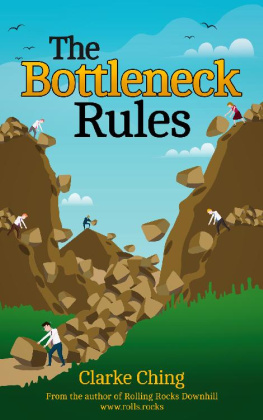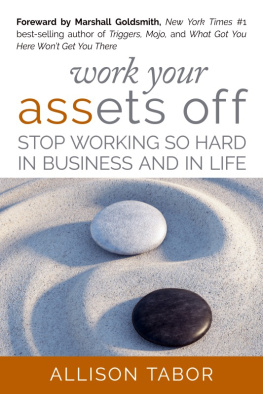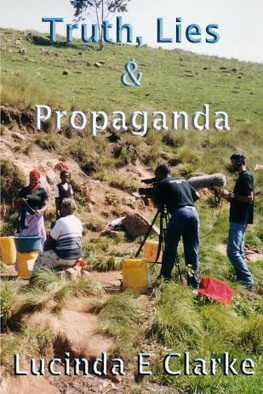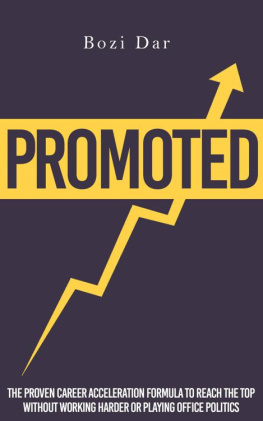The Bottleneck Rules
How to Get More Done (When Working Harder isnt Working)
Clarke Ching
For Winnie, Aisling and Alice.
Copyright 2018 Clarke Ching
All rights reserved
Chapter One
Introduction
"I See Bottlenecks"
"Hes dead."
Its 1999.
Im at the movies with my (now) wife and I just heard the ultimate movie spoiler.
It wasnt meant for me, but quiet whispers travel far in a silent cinema.
Oh, yeah , I thought.
Bruce Willis is dead.
What a clever plot twist.
Were watching the The Sixth Sense , a movie famous for its clever plot twist. Its about a 9-year-old kid who can see and talk to dead people thats his sixth sense. Hes just told Bruce Williss character, a child psychiatrist, I see dead people.
The clever whisperer has just figured out the twist: Bruce Williss character must be dead.
Its so obvious, I think, why hasnt everyone figured it out?
Like all good plot twists, its obvious in hindsight.
*** Spoiler alert ***
I, too, have a sixth sense.
And Im about to teach it to you.
I see bottlenecks.
Soon, you will, too.
Youll see them everywhere.
Before you read on, though, I must warn you that being able to see bottlenecks can sometimes be just about as shocking as seeing dead people.
When you see your first bottleneck, it will hit you like a good movie plot twist does, and you will wonder, How on earth did I not see that until now?
Youll shake your head in disbelief when you realise that something so seemingly harmless has been sitting there, in plain sight, sucking the life out of your workplace and nobody noticed .
The good news is that youre not only going to learn to see bottlenecks youll also learn how to tame them and manage them. Your workplace will speed up and, at the same time, calm down. Taming bottlenecks is easy when you can see them.
I have worked very hard to keep this book short, so that you dont get bogged down in detail, and you get a huge bang for your buck on the time you invest in reading it.
Coming up, you will
Learn the FOCCCUS Formula, which is the surprisingly simple process we use to find and manage bottlenecks.
Discover the five key types of bottlenecks.
See loads of bottlenecks in action*. (The best way to learn to see bottlenecks is by seeing other folks bottlenecks.)
Well start by looking at some everyday bottlenecks. These bottlenecks arent exactly hidden, but you might not have noticed them. Let me show you.
[* Ive changed many of the names (partly to protect the innocent, partly because theyre my friends and I found it amusing to give them funny names) and a good few of the facts (to make them easier and more interesting to learn from). I had the great movie director Alfred Hitchcocks words in mind as I wrote. He said that drama was like real life but with the boring bits taken out. That said, every story you read here is based on a real event. ]
Chapter Two
Everyday Bottlenecks
A few months ago, I was sitting in the front row of a small 13-seater commuter plane at Nelson airport at the top of New Zealands South Island. It was Monday morning. I was on my way to work in Wellington, at the bottom of the North Island.
Its normally a 35-minute flight. Id be in the office by 8:30 a.m.
Or so I thought.
We were all strapped in, the propellers were spinning, and the pilot had just given us the safety speech. I was sitting directly behind him and I could see him chatting away on his headset, requesting permission to take off.
But rather than taxiing to the runway, he switched off the engine, removed his headset, and turned around to face us.
Im sorry, folks. Ive got bad news.
He grimaced.
Wellington is experiencing unexpectedly bad weather. Air Traffic Control has delayed our departure by at least 30 minutes. Im sorry, but Ill need you all to head back into the terminal where its more comfortable to wait. Well get underway as soon as we possibly can.
He then turned to the man sitting beside me, another regular flyer he seemed to know well.
He said, They normally land 12 planes every hour at Wellington but when the weather gets bad, they cut that down to six.
My ears perked up because even though he did not use the word, the pilot had just described the creation of a short-term bottleneck .
The runway was now a bottleneck because it couldnt keep up with the demand placed on it. Because it couldnt keep up, that caused delays.
Thats what a bottleneck is. Its a resource a person, a machine, a computer CPU, a traffic intersection, a slow internet connection, and even an airport runway that cant keep up with the demand placed on it.
Thankfully, this bottleneck was temporary. The weather would return to normal and the airport traffic controllers would revert to their fair weather capacity of 12 flights per hour, or maybe even a little higher than that so that they could play catch-up.
As requested, we deplaned and shuffled back into the terminal, our fingers feverishly texting Sorry, Im going to be late today messages.
The terminal was busy. Its a small, regional airport and we werent the only delayed flight. When I went to get a cup of coffee, there was a long queue ahead of me. Thankfully, it moved quickly and within a few minutes, Id placed my order.
As I paid, though, I noticed a long line of empty cups queued up in front of the barista, waiting for his attention. I knew it made no difference how fast my order was taken if the barista couldnt keep up . So, I took a seat, browsed Twitter, and waited patiently until my coffee arrived about 10 minutes later.
As I sipped my coffee, I pulled out my fancy iPad Pro and fired up Scrivener, the software I use for long-form writing (like this book). I figure I might as well get some writing time in. Theres no point wasting a delay.
I tapped the sync icon and the app started downloading the latest version of my text from the cloud. While I waited, I started trying to figure out how to speed up the airport cafes coffee-making process, just for fun.
You guessed it I started by trying to find the cafes bottleneck resource.
In a multi-step process like coffee-making, the bottleneck determines the speed (and output) of the entire process. If you speed up the bottleneck, you speed up the entire process.
Hmm where was the bottleneck in this 2-step coffee-making process? (Step 1 is taking the order; step 2 is making the coffee.)
Clearly, it wasnt the lady who took my order in step 1. Yes, she had a queue of customers in front of her, but she processed us quickly.









